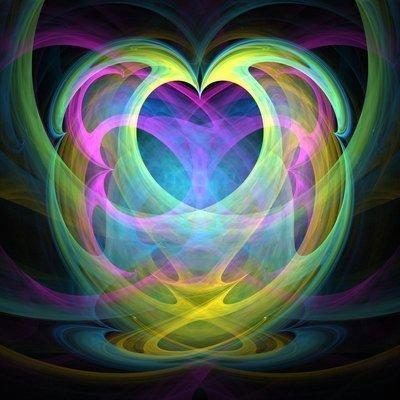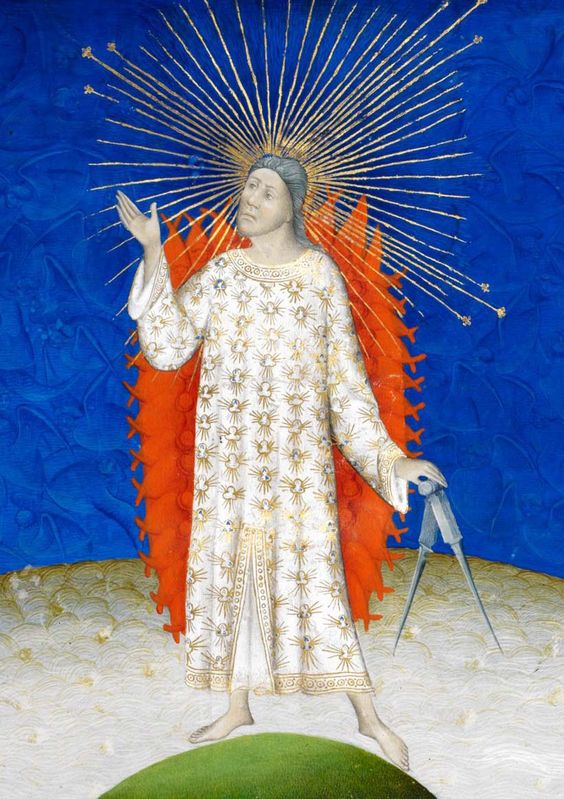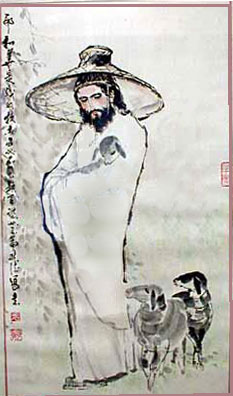
Colorless, Flavorless, Odorless by Deborah Beach Giordano
And God Saw that the Light was Good
 We are told that, at the beginning of creation, light was the first essence drawn forth and the first to be recognized by God as “good.” From that point the days began, and our world took shape. But what is this “light”? It is an aspect of Day — but it is not the sun, which is brought into being later. It is not a thing, not an object, or a shape. Odorless, flavorless, colorless, this light seems to be a sort of condition or essence, a state of being or a kind of power.
We are told that, at the beginning of creation, light was the first essence drawn forth and the first to be recognized by God as “good.” From that point the days began, and our world took shape. But what is this “light”? It is an aspect of Day — but it is not the sun, which is brought into being later. It is not a thing, not an object, or a shape. Odorless, flavorless, colorless, this light seems to be a sort of condition or essence, a state of being or a kind of power.
In the Scriptures we find that wisdom is often described as “light,” and is contrasted with the “darkness” of ignorance. To “walk in the light” doesn’t mean that we’re only supposed to travel when the sun is out, it means that we are to act with understanding and compassion; to be caring as well as intelligent. It means that we follow the holy teachings: that we use our heads as well as our hearts.
This Light is not a color, but a quality; it is brightness, clarity of vision, understanding, insight. More than education or intellect, logic or reasoning, holy Light is an aspect of one’s character: a way of being, of putting knowledge and ability to good use. It is making wise choices, in righteous conduct, in effecting shalom. It is enLIGHTenment.
In contrast with this light is darkness — not a color, but a condition of mind: blindness, unseeing, devoid of understanding; hapless, helpless. It is not ignorance per se, but mis-use or dis-use of potential. Darkness is power and possibilities swirling randomly, confusedly, carelessly, thoughtlessly; stumbling along without direction or concern. It is like going into the basement and choosing not to turn on the light: having wisdom but not putting it to use is dangerous and potentially harmful, even deadly: it keeps us “in the dark.”
Goodness All Around
 In the beginning, God called forth the light — and separated it from the vast swirling all/nothing darkness. Without that separation there would have been no sky or seas, no stars or sun or moon, no earth or its creatures; nothing, only “a formless void.” Power and potential would have continued to swirl and slosh around randomly, accomplishing nothing.
In the beginning, God called forth the light — and separated it from the vast swirling all/nothing darkness. Without that separation there would have been no sky or seas, no stars or sun or moon, no earth or its creatures; nothing, only “a formless void.” Power and potential would have continued to swirl and slosh around randomly, accomplishing nothing.
And God saw that the light was good.
It is as if, in recognizing the light, seeing the goodness within it, the Eternal became conscious, self-aware; awakening to God’s own creative ability from out of pure potentiality.The Light dawns — and it was good. All that is arises from divine illumination.
The Created Order
Working in the Light, the Holy drew forth the heavens and the earth from out of the chaos and confusion. Plants and animals were created, and their continuation was ensured. There would be perennial growth and constant new beginnings: grasses and fruit trees were equipped with seeds to reproduce themselves, animals (and human beings) would, likewise, bring forth others of their kind.
God transformed potentiality from out of the darkness into beauty and order, establishing regular signs and seasons in the heavens and on the earth that we may recognize and interpret. In creation there is consistency that we can rely on; a nurturing that blesses, replenishes, and restores. It is a fully-functioning self-renewing system — and, from the first, God knew that it was “very good.”
The darkness holds opportunities, possibilities, power and potential — but, like the contents of an unlit basement, these cannot be seen. The canned vegetables, Christmas ornaments, spare batteries, shelves, staircase, and spiders are in there, hidden from view; inaccessible. Light illuminates our understanding and enables us to put what is in the darkness to good use — as well as giving us the ability to recognize what we should avoid.
The Light and the Darkness
To convey the profound difference between understanding and ignorance, teachers, priests, and prophets chose the most extreme — and therefor most memorable — comparisons, such as the difference between white and black or between sight and blindness. But these are metaphors, teaching tools: not ultimate truths.
Equally we might use clear/cloudy, nutritious/toxic, clean/dirty as comparisons; but these miss the mark. The point is that there can be no shades of gray, no middle ground, no weasel space to allow even a little bit of consent-to-wickedness to enter in. One either walks in the light or stumbles blindly in the dark; one chooses to follow the Way of the Lord, or refuses to do what is known to be right and good.
He has shown you, O mankind, what is good. And what does the Lord require of you but to act justly, to love mercy, and to walk humbly with your God?
~ Micah 6:8
It is in knowingly ignoring what is good — turning from the holy Way, intentionally leaving the basement light off — that we fall. A righteous life and an unrighteous one are as different as night and day. Or black and white. Or between those who see and those who are blind.
To live in the Light is to draw on holy Wisdom in our conduct and in our thinking. It is following the Way of the Lord, shining the light of understanding on the vast, swirling potentialities in our world. It is making choices that draw forth goodness and beauty, that nurture and build-up; it is an attitude of radiant, life-giving joy.
Literally in the Dark
 It would be ridiculous to believe that those who are sighted are good and wise, and that blind people are evil and ignorant. The same is true of the idea that people are color-coded: that white-skinned folk are a holy tribe, and that black people are stupid or evil. Those who think that way are genuinely in the dark, having succumbed to literal-mindedness.
It would be ridiculous to believe that those who are sighted are good and wise, and that blind people are evil and ignorant. The same is true of the idea that people are color-coded: that white-skinned folk are a holy tribe, and that black people are stupid or evil. Those who think that way are genuinely in the dark, having succumbed to literal-mindedness.
Analogies and metaphors are meant to convey information in a picturesque shorthand: “the light” is like a candle burning in the night — it isn’t literally a candle. Darkness is like an unlighted basement filled with stuff — it isn’t literally a room under a house.
Such words and images are meant to help us. Like the proverbial fingers that point to the moon — but are not the moon, they are guides to lead us to better understanding — not as substitutions for the concepts themselves. The terms Light and Darkness are signposts and indicator lights that can serve to illuminate (!) our thinking, but we will be misled if we take them literally.
The Wisdom of Omission
Who is like you among the gods, O Lord — glorious in holiness, awesome in splendor, performing great wonders?
~ Exodus 15:10
Judaism has traditionally prohibited physical depictions of God: for who can sculpt the wind, or know the color of compassion, or draw a picture of perfect love? It is also a wise and healthy preventative measure: an image is a metaphor and liable — likely — to be misunderstood, and taken literally. The image then becomes an idol, adored and bowed-down to as if it were holy, treated as if it were capable of hearing, and knowing, and performing great wonders. It is perceived to represent holiness — and that sense of holiness will be transferred to whatever (or whoever) resembles it.

And that is why the fact that none of the Gospels describe Jesus’ appearance is a holy gift. We are not told what he looked like — whether he was short or tall, slim or stocky, if his eyes were brown or grey or hazel, his exact age or the day of his birth, whether he wore his hair long or short… All we know is what is ultimately important: his humanity.
The only time that the physical appearance of Jesus is described in the Scriptures is at the Transfiguration. Then, like the Wisdom He brings forth and embodies, the Lord’s essence is revealed as light:
And He was transfigured before them; and His face shone like the sun, and His garments became as white as light.
~ Matthew 17:2
Jesus is of the Light: good and wise, illuminating. Like the Light, He is radiant, glorious; like a candle, regardless of its color, whose flame brings light to the darkness. No single community or people can claim Him or claim His special favoritism. Christ came to all humanity, His Way is open to all Who seek Him — all people, everywhere.
May Wisdom’s light illuminate your understanding,
warm your heart, and guide your path
and, in turn, fall, like holy seed upon good ground.
Christ’s grace and peace be with you,
Deborah ✟
Suggested Spiritual Exercise
Walk in the Light, and let its radiant glory shine forth in you.